On 15 April, thought leaders met in Lyon, France to take part in a panel discussion and Q&A on the potential of advanced therapies and the challenges we face in implementing them in Europe. The event marked the launch of the EBE and Vital Transformation report, “Europe’s Emerging Science: Putting Advanced Therapies into Practice to Deliver Better Health”, a guide to advanced therapies. Advanced Therapies are a reality, with early products hinting at significant therapeutic potential. Although still in the early stages of commercialisation, there is growing evidence of the transformational prospects these products offer. However, hurdles remain in the implementation and use of advanced therapies.
“We felt we need to inform and educate the public about advanced therapies, in particular to inform them of what the main challenges in this field are,” explained Daniela Couto, Founding CEO, Cell2B, of the motivation behind the Report’s creation.
Europe is a world leader in the fundamental science underpinning Advanced Therapies and in the therapeutic use and regulation of tissue, cell and gene therapies – however many see it as being in danger of slipping behind other markets, i.e. the United States, in progressing advanced therapy development, adoption, implementation and use.
Eduardo Bravo, CEO TiGenix and Vice-President EBE, emphasized the fact that Europe has much to offer in the realm of advanced therapies. “We have a strong position in Europe,” he asserted, adding that the basis for advanced therapies – specifically meaning cell therapies, gene therapies and tissue engineering – does lie in Europe. “What we need to ensure is that we don’t lose that position. But what needs to happen to ensure this?” This was the question at hand for the panelists on 15 April – and is what the EBE – Vital Transformation Report seeks to explore in greater detail.
Funding and Financing Issues
Sander Van Deventer, Managing Partner of Forbion Capital Partners, and Founder and Board Member UniQure, highlighted financing and funding as one of the dangerous discrepancies between Europe and the US, pointing to insufficient funding systems in Europe as one issue. “We don’t have a single credible stock exchange for biotechs in Europe – and we have destroyed our investment banks. We see European companies – like UniQure – being listed on NASDAQ, benefiting US banks and US investors.”
“We don’t have a single credible stock exchange for biotechs in Europe –  and we have destroyed our investment banks. We see European companies – like UniQure – being listed on NASDAQ, benefiting US banks and US investors.” – Sander Van Deventer, Managing Partner of Forbion Capital Partners, and Founder and Board Member UniQure and we have destroyed our investment banks. We see European companies – like UniQure – being listed on NASDAQ, benefiting US banks and US investors.” – Sander Van Deventer, Managing Partner of Forbion Capital Partners, and Founder and Board Member UniQure |
Others on the panel agreed, pointing to such examples as bluebird Bio – which focuses on developing new gene therapies for orphan diseases and priced its IPO at $17 a share (raising $101 million after bumping up the number of shares it had on offer) in 2013. The US is not the only other market to keep an eye on. “Japan decided to invest 200 million to become a leader in IPS
Public funding, as well as private investment, is needed, panelists agreed, with Bravo pointing to newer initiatives like Horizon 2020 as showing promise.
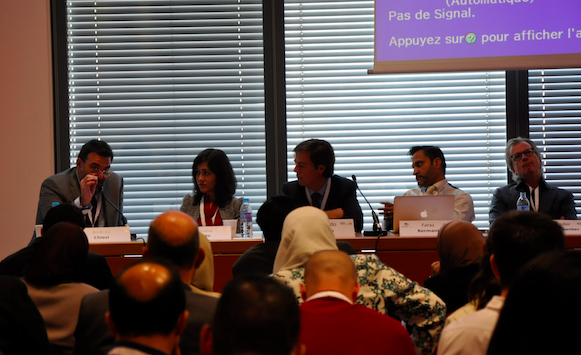
From left to right: Andrea Chiesi, Daniela Couto, Eduardo Bravo, Faraz Kermani, and Sander van Deventer.
An apparent lack of funding does not mean that Europe is at a lack for ideas. On the contrary: At Van Deventer’s Venture Capital firm, Forbion Capital Partners, “we see about 600 business plans per year – but we can only invest, at most, in six companies.” Offering the venture capital perspective, Van Deventer highlighted the difficulties that “big pharma” is facing and pointed to smaller biotechs – most of which are heavily VC-funded – as the being at the forefront of advanced therapies development. “There is no life science development without venture capital. To phrase it even more strictly: There will be no new drugs without venture capital,” he asserted. According to Van Deventer, currently 30-40% of all large pharma blockbusters have been sourced outside (i.e. Lipitor, Fosamax, cozaar, humira, remicade).This is expected to increase to 70% or more. Drugs are sourced from small to medium-sized biotech companies – and virtually all these companies are funded by VC.
Others in the room were more cautious in painting a fragmented picture that poses big pharma against smaller biotechs, noting that larger companies have also explored the potential of advanced therapies. Additionally, it was emphasised that such a polarisation does not help either side – or, in the end, patients.
A Need for Regulatory Stability and Streamlined Reimbursement
Drug development is a long and risky road. Adding complex European regulatory and reimbursement issues into the equation means additional hurdles for advanced therapies in Europe. The investments that are being made in advanced therapies today may not pay off for another ten years – it is thus key that investors can count on regulatory stability and reimbursement that is both consistent and cohesive. This presents a major gap in the current European environment, the panelists agreed.
“Are there better, cleverer, or shorter ways to get these new  products approved?” – Eduardo Bravo, CEO TiGenix, on the lengthy and complex approval and reimbursement process faced by advanced therapies products approved?” – Eduardo Bravo, CEO TiGenix, on the lengthy and complex approval and reimbursement process faced by advanced therapies |
“Are there better, cleverer, or shorter ways to get these new products approved?” asked Bravo. The TiGenix CEO pointed to his own experiences with TiGenix’s ChondroCelect, a product that was approved in 2009 – an approval that was technically allowing for launch in 27 European countries. However, approval does not equate to reimbursement – and approval for reimbursement was significantly varied between countries, Bravo noted.
The complexity doesn’t stop there. In Spain, Bravo’s homeland, there are 17 different reimbursement bodies alone – now multiply that for each European country. “What’s the point in having a drug approved if nobody is going to pay for it?” Bravo asked – a question that his fellow panelist Andrea Chiesi, Director R&D Portfolio Management, Chiesi Farmaceutici, echoed as he described his company’s own experiences in the advanced therapies realm.
Greater Cohesion and Clarity Across Europe
Speaking of his experience with Chiesi Farmaceutici’s Holoclar, Mr. Chiesi gave another compelling example of an additional unique obstacle advanced therapies face in Europe – hospital exemption. On one hand, Holoclar is a landmark for European progressiveness: The European Medicines Agency (EMA) was first to grant approval to this stem cell-based therapy Holoclar, an autologous treatment for Limbal Stem Cell Deficiency caused by chemical or physical burns to the eye.
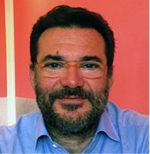 “Unless we have more clarity and coherence in Europe, the next wave of innovation may not see the light.” – Andrea Chiesi, Director R&D Portfolio Management, Chiesi Farmaceutici “Unless we have more clarity and coherence in Europe, the next wave of innovation may not see the light.” – Andrea Chiesi, Director R&D Portfolio Management, Chiesi Farmaceutici |
On the other hand, the case of Holoclar highlights the problematic hospital exemption issue in Europe. The Hospital Exemption Scheme was incorporated into advanced therapies regulation, under which cell and tissue products are prepared on a non-routine basis for treating individual patients. Ultimately, the scheme allows earlier access to experimental treatments.
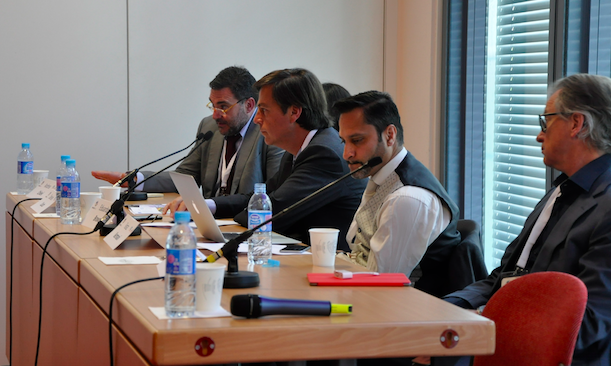 However, some hospitals use the exemption scheme routinely – a problem for companies like Chiesi Farmaceutici who must go down the formal approval routes for their therapies, especially for orphan diseases. It becomes difficult in such cases for a company to get to the market while a hospital is administering apparently similar treatments that are unproven, under the exemption scheme, Chiesi noted, admitting: “If we come back to the venture capital speech and the question What is the probability that we will develop additional products? I do have to ask myself – Why did you do it? But if you ever meet such a patient – i.e. a “butterfly child” you understand why you do it – it’s a disastrous disease,” he ended, referring to Chiesi Faramceutici’s work in the gene therapy treatment of epidermolysis bullosa or “butterfly children disease”.
However, some hospitals use the exemption scheme routinely – a problem for companies like Chiesi Farmaceutici who must go down the formal approval routes for their therapies, especially for orphan diseases. It becomes difficult in such cases for a company to get to the market while a hospital is administering apparently similar treatments that are unproven, under the exemption scheme, Chiesi noted, admitting: “If we come back to the venture capital speech and the question What is the probability that we will develop additional products? I do have to ask myself – Why did you do it? But if you ever meet such a patient – i.e. a “butterfly child” you understand why you do it – it’s a disastrous disease,” he ended, referring to Chiesi Faramceutici’s work in the gene therapy treatment of epidermolysis bullosa or “butterfly children disease”.
“Unless we have more clarity and coherence in Europe, the next wave of innovation may not see the light,” said Chiesi. This was a view widely shared by panelists and the discussions on how to attain greater coherence and clarity made it clear that a collaborative effort across the EU would be needed if success is to be achieved.
Evolving Synergies, Collaboration and Attitudes
Panelists and audience members alike called for a need for greater synergy and collaboration – including diverse input from big pharma to smaller biotechs, to venture capitalists and regulators. Only with this type of behaviour of working together can we find true progress, it was agreed. In a fragmented Europe, however, this can be easier said than done. One audience member noted that fragmentation in Europe has been an issue discussed for many years – and one that remains to be solved.
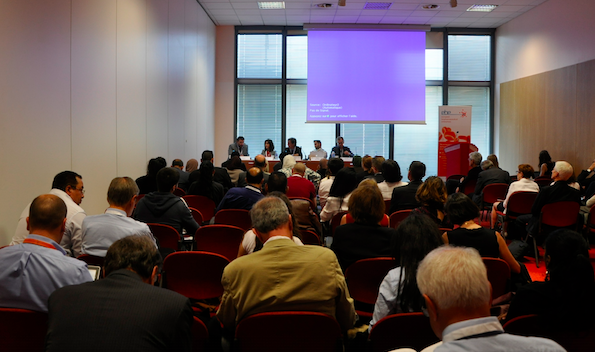 Moderator Faraz Kermani of EFPIA, the European Federation of Pharmaceutical Industries and Associations, asked if the Innovative Medicines Initiative (IMI) might be viewed with optimism. Is this a model worth championing and mimicking further? The public-private partnership brings together diverse companies and research institutes to work on – projects under the auspices of the EU’s Horizion2020 programme.
Moderator Faraz Kermani of EFPIA, the European Federation of Pharmaceutical Industries and Associations, asked if the Innovative Medicines Initiative (IMI) might be viewed with optimism. Is this a model worth championing and mimicking further? The public-private partnership brings together diverse companies and research institutes to work on – projects under the auspices of the EU’s Horizion2020 programme.
While IMI and the second Innovative Medicines Initiative, IMI2, do represent an impressive model of collaboration (and collaborative funding), it was made clear that collaboration is about more than money. Behaviours and attitudes need to change if collaborative efforts are to succeed.
“One of the biggest challenges is cultural change,” noted Couto. Van Deventer agreed, also pointing out the fact that patients are becoming better informed and more vocal about the access to new medicines they may or may not have. Others in the room questioned whether EU culture is, as a whole, too risk-averse, especially in comparison to other markets, i.e. the US.
 “What we need is smart money.” – Daniela Couto, Founding CEO, Cell2B, on the need for well-informed monetary investments in the advanced therapies field “What we need is smart money.” – Daniela Couto, Founding CEO, Cell2B, on the need for well-informed monetary investments in the advanced therapies field |
Changes in financing and funding models, as highlighted by Van Deventer and others, would be a good step forward. But this isn’t enough – attitudes need to change too. “What we need is smart money,” Couto stated, making it clear that increased collaboration and funding in the EU will require an evolution of thought if advanced therapies are to achieve their full potential in Europe. Monetary investments need to be well-informed and “smart money” will take us further than uninformed investment.
Conclusion
The hope for pharma lies in what is new. New things drive the market forward and new medicines are what patients need. To secure potential benefits of advanced therapies, there must be support for clinical translation, and a regulatory and reimbursement framework that will allow these products to move on from the one-off, hospital-scale model, to become a commercial, European-scale sector.
The diversity of hurdles that advanced therapies face requires input from many different parties, as the panelists emphasised. The Report they were there to discuss was created in consultation with stakeholders from a broad spectrum, ranging from venture capitalists to regulators to biopharmaceutical experts.
Europe has the foundations in place to progress advanced therapy use. That much is clear. “The time for advanced therapies is now,” said Bravo. There was no disagreement among the panelists that this was true. The question, now, is how to ensure that Europe meets that potential. This is what the 15 April panel in Lyon sought to explore – and what the EBE – Vital Transformation Report examines in greater detail.
Download the full report here.
About the Report
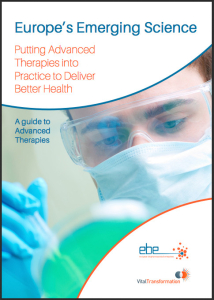 The EBE – Vital Transformation report “Europe’s Emerging Science: Putting Advanced Therapies into Practice to Deliver Better Health” provides a guide to Advanced Therapies, seeks expert views on how to drive adoption, and considers obstacles in scaling-up manufacturing, meeting the requirements of regulators and securing reimbursement.
The EBE – Vital Transformation report “Europe’s Emerging Science: Putting Advanced Therapies into Practice to Deliver Better Health” provides a guide to Advanced Therapies, seeks expert views on how to drive adoption, and considers obstacles in scaling-up manufacturing, meeting the requirements of regulators and securing reimbursement.
Prepared by the Advanced Therapies and Emerging Science Working Group of the European Biopharmaceutical Enterprises, in collaboration with Vital Transformation, the report aims to further the collaborative discussion on emerging sciences and advanced therapies – with the ultimate outcome of delivering better care for patients.
Download the full report here.
This report was produced in collaboration with the European Biopharmaceutical Enterprises (EBE).

